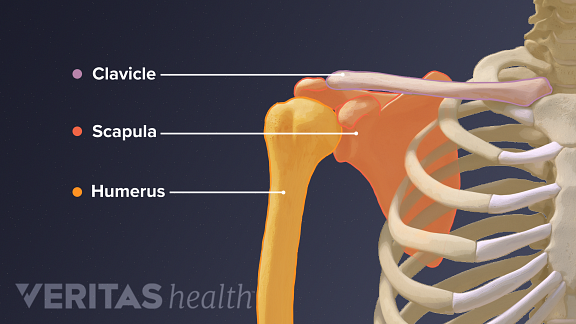Guide to Shoulder Anatomy
Shoulder Bones: For upon|The shoulder is a strong and flexible ball-and-socket joint that connects the arm to the torso, and it is considered one of the most mobile parts of the body. It is responsible for:
- Moving and rotating the upper arm
- Overhead weight-bearing
- Reaching behind the back
The shoulder is composed of a network of bones, joints, and soft tissues that make this large range of motion possible.
The most common shoulder injuries involve the muscles, ligaments, cartilage, and tendons, rather than the bones. Common shoulder injuries include rotator cuff tears, shoulder impingement, and dislocation. Athletes, such as tennis or football players, and people who work in occupations that require frequent, heavy, overhead lifting are most susceptible to shoulder injuries.
Shoulder Bones

The shoulder bones include the scapula (shoulder blade), humerus (upper arm bone), and clavicle (collarbone). The joints between these bones are flexible and allow for a wide range of motion.
The shoulder is made up of 3 bones:
- The scapula (shoulder blade). The scapula is a large, flat, and somewhat triangular bone that sits between the humerus (upper arm bone) and collarbone. It is responsible for stabilizing the upper arm bone, which sits in a shallow socket on the outer edge of the shoulder blade.
- The humerus. This is the bone of the upper arm. The top of the humerus is rounded and fits into the shallow socket of the scapula, called the glenoid cavity, creating the shoulder’s ball-and-socket joint. This ball-and-socket construction allows for the arm’s large range of motion.
- The clavicle (collarbone). The collarbone is a long and thin bone located between the shoulder and the top of the ribcage. The collarbones help support and keep the arms in place when away from the body.
All 3 bones are susceptible to injury and trauma, including fractures and dislocations.
Joints of the Shoulder

Four major shoulder joints help to achieve a complex range of motion: the glenohumeral joint, the acromioclavicular joint, the scapulothoracic joint, and the sternoclavicular joint.
Joints are where 2 or more bones meet. While the shoulder is often referred to as a singular joint, it is technically made up of 4 joints.
Two of these joints are more susceptible to injuries:
- Glenohumeral joint. This joint is considered the main joint in the shoulder and is where the rounded top, or head, of the humerus (arm bone), nestles into the shallow, rounded socket of the scapula (shoulder blade) like a golf ball on a tee. The medical term for the shoulder socket is the glenoid cavity. This ball-and-socket construction allows for circular movement of the arm.
-
Acromioclavicular joint (AC joint).
- The acromioclavicular joint is located where the clavicle (collarbone) glides along the acromion, located at the top of the shoulder blade. The AC joint is considered a gliding synovial joint, which means it allows the bones to move side-to-side, up and down, and diagonally. The acromioclavicular joint mainly helps facilitate raising the arm over the head.
The other 2 shoulder joints are less well-known and less likely to be injured:
- Sternoclavicular joint. The sternoclavicular joint is where the clavicle (collarbone) meets the sternum (breastbone). It connects the upper arm to the rest of the body. The sternoclavicular joint is considered a gliding synovial joint and helps facilitate a number of shoulder movements, including shrugging, extending the arm behind the body, and moving the shoulders forward and backward.
- Scapulothoracic joint. This joint is located where the scapula glides against the rib cage at the back of the body. Not everyone considers this area a joint because the bones are not attached by ligaments.
The shoulder is essential to arm movement and therefore critical to most everyday activities, such as driving and cooking. A healthy shoulder allows the arms to move up and down, side-to-side, forward and backward, and to perform reaching movements.
Articular Cartilage in the Shoulder
Like all joints in the body, the shoulder joints’ bony surfaces are covered in articular cartilage. Articular cartilage is a slippery, strong, and flexible material. It has 2 functions:
- Allows two bones to move or glide against one another. This means that, in a healthy shoulder, movement is smooth and pain-free.
- Cushions bones from impacting one another. Articular cartilage acts as a shock absorber during high-impact activities, such as tennis or gymnastics.
Articular cartilage is often thinner in the shoulder than it is in weight-bearing joints, such as the knees and hips. When articular cartilage in the shoulder is damaged, it can significantly affect the shoulder’s ability to withstand friction and impact.
The damage and loss of articular cartilage are called osteoarthritis. The glenohumeral joint and acromioclavicular joint are susceptible to this and other types of arthritis.
Nearby soft tissues, such as the rotator cuff, support the shoulder joints and are also susceptible to damage.


Comments are closed.